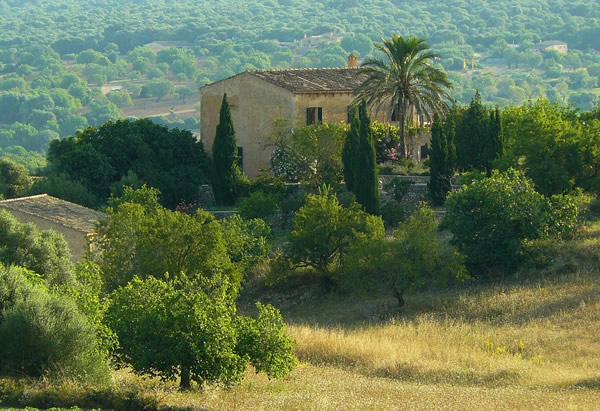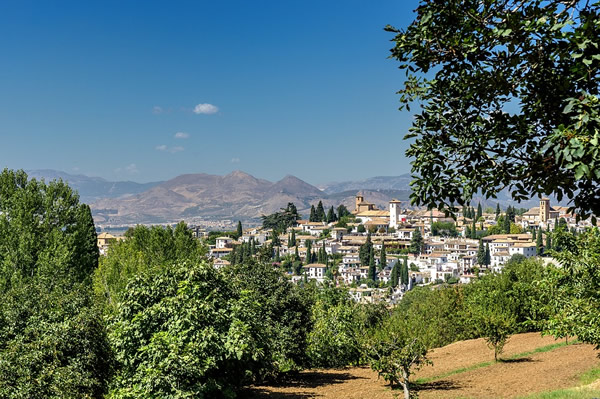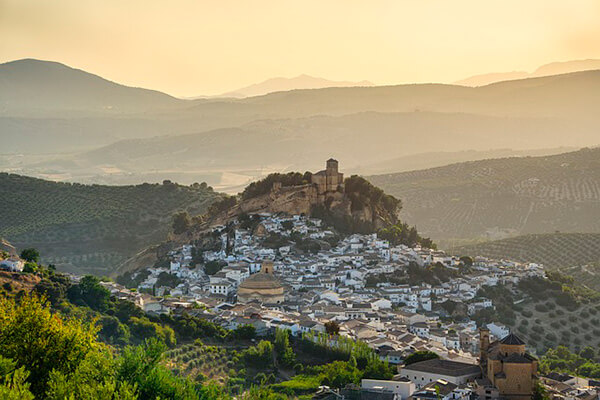Live the Dream: Buying a Home in Spain
By Allan Ashton

|
|
A country house in southern Spain.
|
Adios!
We set out from Portsmouth docks in search of a new home and life in Spain or maybe Portugal. Such was the disillusionment with our homeland. Over 50 is over the hill in the UK, and worthwhile employment is practically non-existent, so it was a case of getting all bitter and twisted or doing something about it. So we did something about it.
Headin’ South
We arrived in Bilbao in a force 9 gale. We pressed on through some pretty but drenched countryside. We soon realized how diverse and stunningly beautiful Spain can be, even in the rain. An overnight stop in an alpine-like town called Avila, and we headed south — to the sun we hoped.
Our first two weeks were spent in an urban center called Camposol near the town of Mazarron, which lies in the province of Murcia. The Bay of Mazarron is close to but worlds apart from the famous and ugly La Manga, the playground of the rich and famous. Mazarron has two parts, one inland and the other on the coast. The coastal Puerto Mazarron is a holiday resort for the Spanish. It has a beautiful disposition with clear seas and pristine beaches surrounded by mountains. The resort is virtually deserted and very peaceful for ten months of the year. Getting to this region involves a tedious journey over a mountain range, but that isolation keeps away the tour companies.
Camposol is a vast urban center in a valley surrounded by mountains. There are about 4,000, mainly Brits here, with a high percentage being residential. We visited various properties during these first two weeks, from cave houses to prefabricated modular homes. Since our last visit here a year ago, prices have rocketed almost beyond our budget.

|
|
An old hilltop village with olive and other trees is seen from a green hillside. |
Granada and Beyond
So it was time to set about our travels, first up an area north of Murcia, "Vale de Ricotte," which sounded lovely but wasn't. However, all this was compensated for by the guy who showed us around; he was a real character and quite the most politically incorrect guy I have ever met.
Political correctness is virtually non-existent in Spain; you can insult who you like without incurring a lawsuit. Houses here rated a big fat zero for us, but our guide got a ten for entertainment value.
After two weeks of house hunting, we gave ourselves a break and went to Granada in the province of Andalusia. The scenery around Granada is stunning and lies close to the permanently snow-capped Sierra Nevada mountains. Granada's slogan is skiing in the morning and beach balls in the afternoon. There was a knock at the window while driving around the city, lost and stuck in a traffic jam. It was a guy on a scooter wearing some uniform. I slowly opened the window, expecting trouble. "Buenos dias señor," he says," You are looking for somewhere yes?" Turns out that he was from the tourist board and kept his eye out for lost souls like ourselves. He told us the hostel we were looking for was closed, but he knew somewhere else and asked us to follow him. We eventually came across this small hotel, after which he ensured we were satisfied, wished us a pleasant stay, hopped on his Vespa, and was gone.
We had a good time in Granada. We watched a couple of bulls and about 30 sweaty bodies pull a magnificent-looking shrine on wheels up to the cathedral, only to see it topple over on the church steps. There was lots of shouting and gestures before they stood the shrine back up. By this time, the bulls had done what comes naturally, and everybody began to slip all over the place, much to the amusement of us onlookers. Then it was midnight, the salsa band came, and the whole square came alive with a gyrating mass of dancers, except the shrine pushers, who were given space and left to dance alone.
Spaniards eat late, around 10 p.m., and party till the small hours. It's a country for night owls, so different from the lifestyle of Northern Europeans and many Americans.

|
|
An old hilltop village with olive and other trees is seen from a green hillside. |
Next on our list was a place called Iznajar, which lies some 40 minutes or so inland from Granada, and such is the contrasting Spanish scenery that we went from rugged mountainous terrain to deep lush green hills and rolling valleys. We eventually came to a white village on a steep hill surrounded by a vast lake. This place is not mentioned in guidebooks and is entirely untouched by tourism. Long may it remain so. The only English here are real estate people — well, who else — and property was quite reasonable, which is to be expected. With every beer, you get a welcoming smile and a plate of tapas, an Andalusian tradition, but you need cloven hooves to get around the streets as they are all hills. Sadly, this was an impractical place to live for us, but we will return one day.
The Coast of Light
And so we set off to Arcos de la Frontera, heading towards the Costa de la Luz region town frequented by day tourists and left to the locals at night. It is built on a clifftop with sheer drops on either side. It has a significant history full of medieval trickery and decadence. Our ancient hostel was patronized by the rich and famous in centuries gone by; the gentle sound of horse and cart is now being replaced by the sounds of Yamaha and Suzuki all night. There are some attractive property options here, but it didn't exactly mesmerize us.
The Costa de la Luz region runs from the Portuguese border to Gibraltar. It is one of our favorite places, Vejer de la Frontera. Vejer is not far from Gibraltar and is a picturesque white village built on a hilltop, not unlike Monte Carlo in many respects. It has lovely countryside views on one side and looks over Cape Trafalgar, the famous sea battle site, on the other.
We spent three days checking out the Costa de la Luz area. We stayed in a pleasant and inexpensive hostel right in Vejer itself. Property prices were once again pretty high, and while Vejer had an air of Monte Carlo about it, it also resembled a Monte Carlo-style race track at night.
Next, we traveled to Seville, the home of flamenco and bullfighting. It is the most beautiful city in Spain, but we had been there previously. With the weather boiling at 39 °C (102°F) in mid-May, we moved swiftly down to the Portuguese border and Ayamonte. We liked Ayamonte; it is a lovely, unspoiled border town with plenty of character. Our real estate agent showed us some interesting properties overlooking the river and suspension bridge to Portugal, and we were impressed even though it would have really stretched the budget. We also visited some less interesting properties in Isla Canela, which was comparatively devoid of character — boasting mainly a pleasant beach.
The Portuguese Algarve
We have had a timeshare in Algarve for over 15 years and know the area well. The region features some of the most beautiful beaches in Europe, and it's a home from home. We headed for a town some 10-15 miles from the coast called Silves and found some property within our price range. Lovely old farmhouses with plenty of land, but so much work was required we had to pass. The Algarve is different from the intensity of Spain — almost gentile by comparison. Everybody speaks English, even the movies are in English. Beautiful beaches, good climate, peaceful, lovely people who eat and go to bed at what are for us reasonable hours. What more could we want? Some fun in our senior lives, that's what. Spain received our vote.
Ronda
On our way back, we visited Ronda, a European "Grand Canyon" ( a small one, but still very impressive). We stayed in some rundown old hacienda run by a lovely, eccentric English Lady who regarded us as kindred spirits. She asked if we would consider running the place in the winter while she visited family in the US. My wife was sorely tempted; I was sorely not.
Decision time
Both Ronda and the Granada region offer some affordable properties in lovely locations. Nonetheless, our research led us to discover that the weather in winter can be as cold and gray as the UK — so no thanks. We returned to Mazarron via the Costa del Sol coast road. If you pass through any coastal town in this region, you won't find the Spanish language written anywhere, and that's not for us. Likewise, Almeria is very desert-like and also not for us.
We traveled over 2,000 miles from tourist areas, saw some lovely places, and met interesting characters from seemingly every nation on earth. Ultimately, we ended up where we started, back in Mazarron, where we decided to settle — as this region is still relatively unspoiled.
Living in Spain
Our new home is in Camposol, and we decided to live here because it suits our personal needs. Nevertheless, urban living is certainly not for everyone. We are now full Spanish residents familiar with antiquated Spanish bureaucracy and banking. Spain is a relatively new democracy, but the legacy of Franco still exists. Murcia was the last region to fall to Franco, and the people here were denied any form of social /educational services throughout his dictatorship. Consequently, most older folk cannot read or write and must live off the land.
Land is under constant siege from developers, but rural land construction is strictly controlled. However, unscrupulous developers have built and sold property to purchasers who find their property illegal and subject to demolition. Sadly, this has happened, which is another reason why urban living is worth considering.
Unless you are a tradesman or a musician, work is not easy to come by. Without a reasonable command of the Spanish language, jobs are hard to find.
Wow! So what about all the great things in Spain? Well, apart from the sunshine and lovely rugged scenery, it's the way of life that makes it all worthwhile. Forget the "service-driven" societies of the US and the UK. In Spain, cash is king, credit cards are unpopular, and everything stops for fiestas. There is a public holiday, or two, every month, some of which are called "red days." If you're caught working (hammering, drilling, sawing, etc.), citizens receive a €3000 fine. Spain is a society that values and respects its older generation, and Spaniards work to live, not the other way around. Extreme stress and heart attacks are relatively rare, and fiestas are paramount. Walk down any high street in provincial Spain between 2-5 p.m. siesta time, summer and winter, and it is a ghost town — remnants of a long and revered tradition.
In Spain, it is best to choose immersion and avoid isolation. Explore the land thoroughly and treat the people respectfully. Try to learn the language as much as possible; even knowing a little will help open many doors. You will then be ready to enjoy living the dream.
For More Information
See Living in Spain: Essential Expatriate Resources and Articles on this site for a much more information about the country.
Allan Ashton
spent many years as a technical author/editor in such industries as office automation, stage lighting, and telecoms and has been fortunate enough to have traveled extensively. At one time or another, Allan has been responsible for user manuals, publicity releases, travelogues, newsletters, and web editing. He has also written some articles for UK music magazines.
Since 2004, Allan and his wife have semi-retired in Spain. Allan now freelances for local publications, helps with the communal newsletter, and plays drums in a local band. Allan says: "You're never too old to rock n roll."
|
